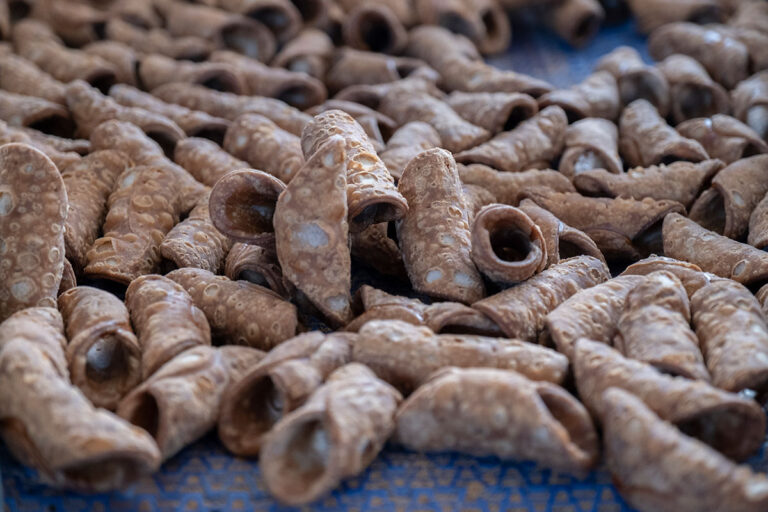How to Make Sicilian Cannoli: Complete Guide for Professionals
How to make Sicilian cannoli? Sicilian cannoli are one of the most iconic desserts in the world and represent the quintessential Italian confectionery tradition.
In this guide you will discover how to make Sicilian cannoli step by step, using artisanal techniques that guarantee crisp, golden shells.
If you run a bakery, café, or catering business, knowing the production process will help you evaluate whether it makes sense to make the cannoli in-house or to rely on a specialized supplier.
How to Make Sicilian Cannoli: Essential Ingredients

High-quality ingredients are needed to achieve an authentic result:
00 flour
Lard or butter
Sugar
Bitter cocoa
Egg
Dry white wine
Pinch of salt
Pro tip: Using certified raw materials ensures consistent yields, which is crucial for those working on large volumes.
How to Make Sicilian Cannoli: Preparing the Dough
Mix flour, sugar, cocoa and salt.
Incorporate the lard until a sandy dough is obtained.
Add wine and egg and process until smooth.
Cover the dough and let it rest in the refrigerator for at least one hour.
This step requires time and experienced staff, especially for daily productions.
How to Make Sicilian Cannoli: Drafting and Forming.
The dough should be rolled out into a very thin sheet (1-2 mm).
Cut discs or ovals, roll them onto cylinders, and seal the edges with egg white.
Uniformity and precision are essential to ensure the same yield in the window.
How to Make Sicilian Cannoli: Perfect Frying.
Heat oil to 175°C and fry a few shells at a time for 1-2 minutes.
Drain well and let cool on paper towels before removing the cylinders.
Mistake to avoid: if the oil is not hot enough, the shells absorb too much fat and lose crispness.
Artisan Techniques vs. Industrial Production of Cannoli
We adopt a controlled craft process in our workshop to ensure:
Natural golden color
Uniform crispness
Perfect shells without burns
Industrial production is faster, but often sacrifices quality. For a venue, the difference is noticeable and affects customer satisfaction.
Tips for Sicilian Cannoli Always Crispy
Stuff the cannoli only before serving.
Store the shells in a cool, dry place.
Use well-drained ricotta to prevent it from wetting the pastry.
Mistakes to Avoid When Making Sicilian Cannoli
Pastry too thick → hard shells
Unheated oil → greasy cannoli
Cream too liquid → soft shells
Dough rest too short → dough sheet not very elastic
Want to Avoid Production? Sicilian Cannoli Supply Wholesale
Making cannoli in-house takes time, machinery and skilled staff.
With our wholesale supply of Sicilian cannoli, you receive ready-made, crispy, safely packaged shells.
Mignon, medium and large sizes available
Customized batches for bars, bakeries and caterers
Fast and tracked shipping to Italy and the World
Request a customized quote now and find out how to simplify your production without sacrificing quality.
FAQ on how to make Sicilian cannoli.
How not to make Sicilian cannoli soften?
Stuff only at the moment. Store shells in airtight containers in a cool, dry place, away from moisture and temperature changes.
How to make Sicilian cannoli without cylinders?
Use food tubes or smooth handles as a mold, seal the edges with egg white and fry at 175°C for 1-2 minutes.
How to make Sicilian cannoli dough?
Flour, sugar, cocoa and salt with lard; add wine and egg. Dough smooth, rest 60 minutes in refrigerator before rolling out.
How to make the peels of Sicilian cannoli?
Roll out thin, wrap on cylinders and seal with egg white. Fry at 175°C until golden brown; drain and let cool.
How to make the cream for Sicilian cannoli?
Sheep’s milk ricotta cheese well drained with powdered sugar; add chocolate chips or pistachios. Stuff just before serving.
How to make Sicilian cannoli cylinders?
Food-grade stainless steel tubes 2-3cm: cuts, smooths edges and sanitizes. Alternatively, ready-made pastry cylinders.
How to make ricotta cheese for Sicilian cannoli?
Drain 12-24 hours, process with powdered sugar and flavorings. Consistency smooth and dry so shells do not get wet.




